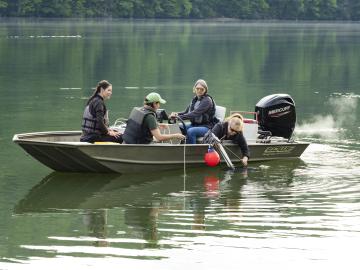
Filter News
Area of Research
- (-) Biology and Environment (177)
- (-) Clean Energy (522)
- (-) Neutron Science (190)
- Advanced Manufacturing (34)
- Biological Systems (18)
- Biology and Soft Matter (5)
- Building Technologies (12)
- Chemical and Engineering Materials (4)
- Chemistry and Physics at Interfaces (11)
- Climate and Environmental Systems (14)
- Computational Biology (6)
- Computational Chemistry (5)
- Computational Engineering (5)
- Computer Science (19)
- Data (1)
- Earth Sciences (1)
- Electricity and Smart Grid (3)
- Energy Frontier Research Centers (14)
- Energy Sciences (5)
- Fossil Energy (3)
- Fuel Cycle Science and Technology (3)
- Functional Materials for Energy (16)
- Fusion and Fission (54)
- Fusion Energy (17)
- Geographic Information Science and Technology (3)
- Isotope Development and Production (3)
- Isotopes (35)
- Materials (433)
- Materials Characterization (2)
- Materials for Computing (36)
- Materials Synthesis from Atoms to Systems (13)
- Materials Under Extremes (12)
- Mathematics (1)
- National Security (79)
- Neutron Data Analysis and Visualization (4)
- Nuclear Science and Technology (74)
- Nuclear Systems Modeling, Simulation and Validation (3)
- Nuclear Systems Technology (1)
- Quantum Condensed Matter (4)
- Quantum information Science (9)
- Reactor Technology (1)
- Renewable Energy (4)
- Sensors and Controls (5)
- Supercomputing (311)
- Transportation Systems (11)
News Type
News Topics
- 3-D Printing/Advanced Manufacturing (82)
- Advanced Reactors (6)
- Artificial Intelligence (20)
- Big Data (15)
- Bioenergy (68)
- Biology (81)
- Biomedical (30)
- Biotechnology (16)
- Buildings (36)
- Chemical Sciences (20)
- Clean Water (21)
- Climate Change (59)
- Composites (19)
- Computer Science (50)
- Coronavirus (27)
- Critical Materials (9)
- Cybersecurity (9)
- Decarbonization (48)
- Energy Storage (76)
- Environment (141)
- Exascale Computing (6)
- Fossil Energy (3)
- Frontier (6)
- Fusion (2)
- Grid (41)
- High-Performance Computing (25)
- Hydropower (9)
- Isotopes (2)
- Machine Learning (16)
- Materials (49)
- Materials Science (50)
- Mathematics (5)
- Mercury (10)
- Microelectronics (1)
- Microscopy (17)
- Molten Salt (1)
- Nanotechnology (20)
- National Security (9)
- Net Zero (5)
- Neutron Science (100)
- Nuclear Energy (9)
- Partnerships (12)
- Physics (11)
- Polymers (13)
- Quantum Computing (1)
- Quantum Science (8)
- Renewable Energy (2)
- Security (8)
- Simulation (17)
- Space Exploration (6)
- Statistics (1)
- Summit (17)
- Sustainable Energy (93)
- Transformational Challenge Reactor (3)
- Transportation (68)
Media Contacts

ORNL's Climate Change Science Institute and the Georgia Institute of Technology hosted a Southeast Decarbonization Workshop in November that drew scientists and representatives from government, industry, non-profits and other organizations to

Used lithium-ion batteries from cell phones, laptops and a growing number of electric vehicles are piling up, but options for recycling them remain limited mostly to burning or chemically dissolving shredded batteries.

Scientists at ORNL used their knowledge of complex ecosystem processes, energy systems, human dynamics, computational science and Earth-scale modeling to inform the nation’s latest National Climate Assessment, which draws attention to vulnerabilities and resilience opportunities in every region of the country.

ORNL researchers demonstrated that an additive made from polymers and electrolytes improves the thermal performance and stability of salt hydrate phase change materials, or PCMs, a finding that could advance their integration into carbon-reducing heat pumps.

Griffiths and her colleagues are examining how much methane and carbon dioxide is released from the reservoir. Their aim is to better understand and predict how much of these climate-warming gases are coming from reservoirs across the nation.

While completing his undergraduate studies in the Philippines, atmospheric chemist Christian Salvador caught a glimpse of the horizon. What he saw concerned him: a thin, black line hovering above the city.

Researchers at ORNL have been leading a project to understand how a high-altitude electromagnetic pulse, or EMP, could threaten power plants.

Scientists at ORNL used their expertise in quantum biology, artificial intelligence and bioengineering to improve how CRISPR Cas9 genome editing tools work on organisms like microbes that can be modified to produce renewable fuels and chemicals.

The founder of a startup company who is working with ORNL has won an Environmental Protection Agency Green Chemistry Challenge Award for a unique air pollution control technology.

The Hub & Spoke Sustainable Materials & Manufacturing Alliance for Renewable Technologies, or SM2ART, program has been honored with the composites industry’s Combined Strength Award at the Composites and Advanced Materials Expo, or CAMX, 2023 in Atlanta. This distinction goes to the team that applies their knowledge, resources and talent to solve a problem by making the best use of composites materials.


